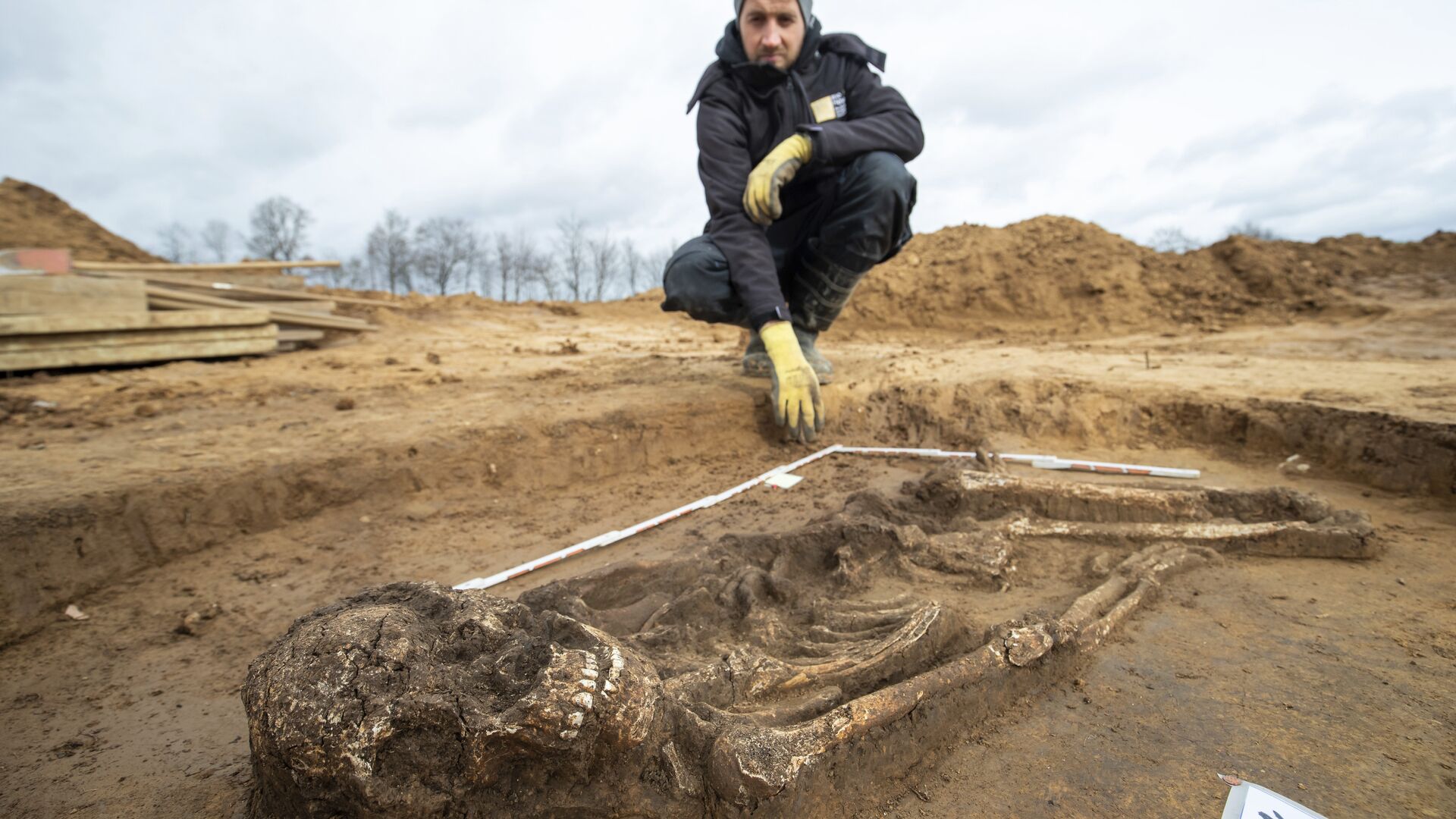https://sputnikglobe.com/20240129/strangely-adorned-skeletons-found-in-1000-year-old-kiev-cemetery-1116458427.html
Strangely Adorned Skeletons Found in 1,000-Year-Old Kiev Cemetery
Strangely Adorned Skeletons Found in 1,000-Year-Old Kiev Cemetery
Sputnik International
A 1,000-year-old cemetery—located about 50 miles south of Kiev—has revealed over 107 skeletons that were buried with rings around their necks and buckets on their feet. The mass grave is believed to be a pagan-era cemetery, and provides researchers with a better glimpse into the Dark Ages.
2024-01-29T04:43+0000
2024-01-29T04:43+0000
2024-01-29T04:43+0000
beyond politics
archeology
skeleton
human skeletons
kiev
ukraine
https://cdn1.img.sputnikglobe.com/img/107303/62/1073036243_0:406:5472:3484_1920x0_80_0_0_d9a197064f9c95854ea237f5cfbd31a6.jpg
A 1,000-year-old cemetery—located about 50 miles south of Kiev—has revealed over 107 skeletons that were buried with rings around their necks and buckets on their feet. The mass grave is believed to be a pagan-era cemetery, and provides researchers with a better glimpse into the Dark Ages.Unearthing the cemetery also revealed axes, swords, spears, jewelry, bracelets, beads and the remains of food offerings such as eggshells and chicken bones.The weapons are typical for Kievan Rus’ and northeastern Europe, says researchers Vsevolod Ivakin and Vyacheslav Baranov, who led the excavation. The two presented their findings at the Archaeological Institute of America annual meeting in Chicago in early January, according to one report.According to the researchers, the cemetery included both men and women and “most of the identified burials were deposed in wooden coffins”.While some of the men seemed to have been buried with weapons, a few of the women were found with elaborate neck rings that may have acted as a social marker. Some of the remains were also found with wooden buckets at the feet, which could have been part of funerary rituals, and has been found within burials around this region.A stone altar was also found at the site and could have been used for early Christian rituals or pagan rituals. At the time of this cemetery’s use, the people in this region were undergoing a conversion to Christianity, which can be dated back to the baptism of Vladimir the Great around 987, before his marriage to Anna, the sister of the Byzantine emperor Basil II.
kiev
ukraine
Sputnik International
feedback@sputniknews.com
+74956456601
MIA „Rossiya Segodnya“
2024
News
en_EN
Sputnik International
feedback@sputniknews.com
+74956456601
MIA „Rossiya Segodnya“
Sputnik International
feedback@sputniknews.com
+74956456601
MIA „Rossiya Segodnya“
archeology, ukraine, kiev, human skeletons, skeleton, cemetery, inhumation cemetery, stone altar, strange skeleton, dark ages, kievan rus’, kievan rus
archeology, ukraine, kiev, human skeletons, skeleton, cemetery, inhumation cemetery, stone altar, strange skeleton, dark ages, kievan rus’, kievan rus
Strangely Adorned Skeletons Found in 1,000-Year-Old Kiev Cemetery
The skeletons were found adorned with buckets on their feet and rings around their necks.
A 1,000-year-old cemetery—located about 50 miles south of Kiev—has revealed over 107 skeletons that were buried with rings around their necks and buckets on their feet. The mass grave is believed to be a pagan-era cemetery, and provides researchers with a better glimpse into the Dark Ages.
Unearthing the cemetery also revealed axes, swords, spears, jewelry, bracelets, beads and the remains of food offerings such as eggshells and chicken bones.
The weapons are typical for Kievan Rus’ and northeastern Europe, says
researchers Vsevolod Ivakin and Vyacheslav Baranov, who led the excavation. The two presented their findings at the Archaeological Institute of America annual meeting in Chicago in early January, according to one
report.
According to the researchers, the cemetery included both men and women and “most of the identified burials were deposed in wooden coffins”.
While some of the men seemed to have been buried with weapons, a few of the women were found with elaborate neck rings that may have acted as a social marker. Some of the remains were also found with wooden buckets at the feet, which could have been part of funerary rituals, and has been found within burials around this region.
“Other elements, such as buckets from two Ostriv male graves, are also found at 11th-century Prussian cremation and Pomeranian and Masovian inhumation cemeteries of military elites,” the
researchers said.
A stone altar was also found at the site and could have been used for early Christian rituals or pagan rituals. At the time of this cemetery’s use, the people in this region were undergoing a conversion to Christianity, which can be dated back to the baptism of Vladimir the Great around 987, before his marriage to Anna, the sister of the Byzantine emperor Basil II.


